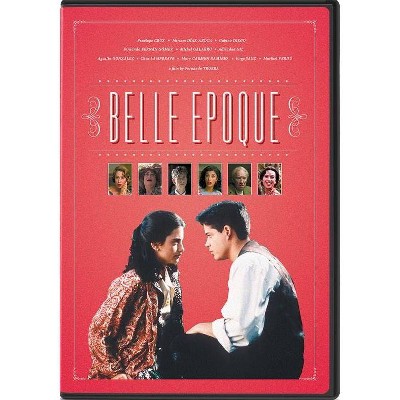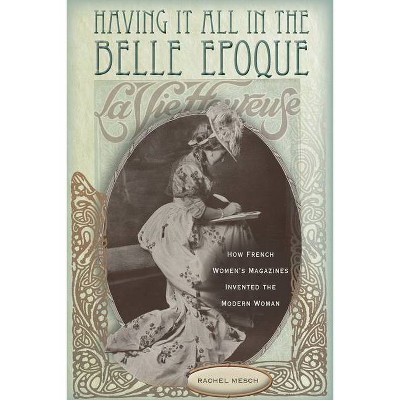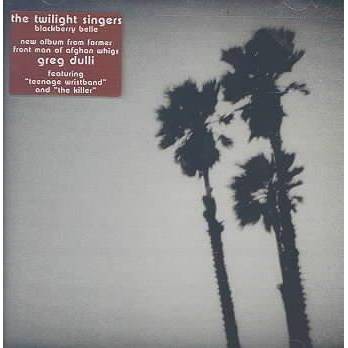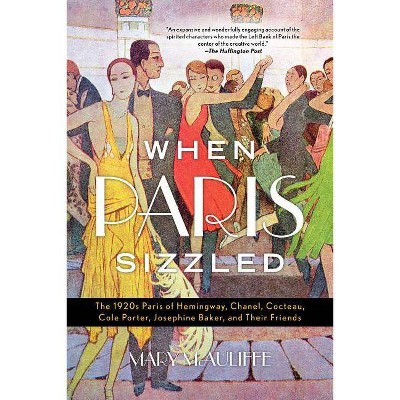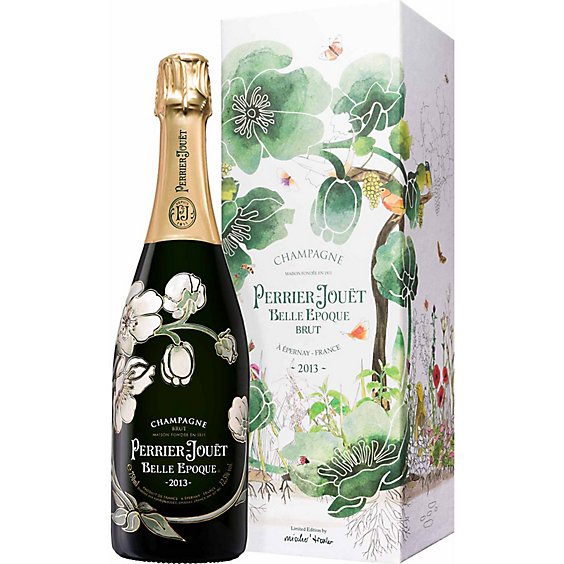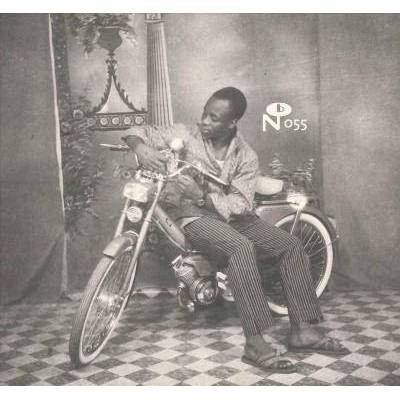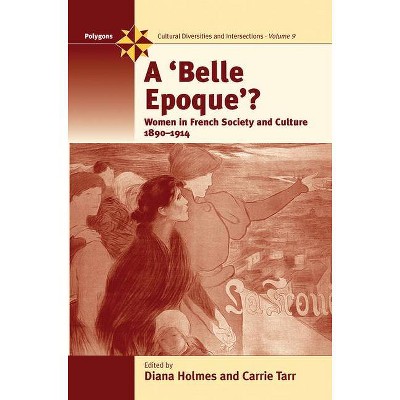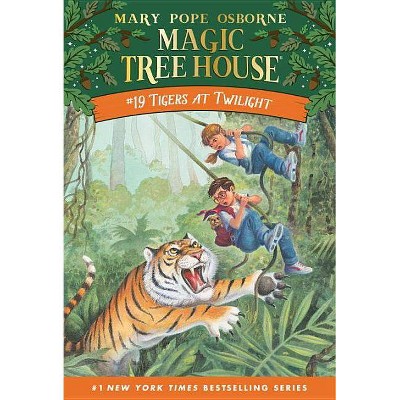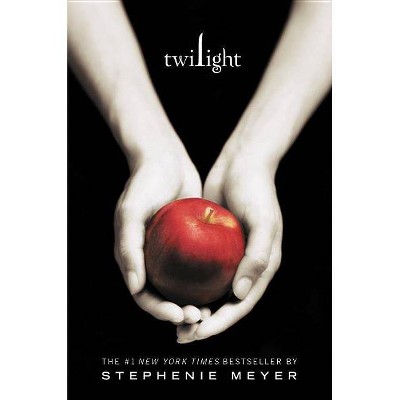Twilight of the Belle Epoque - by Mary McAuliffe (Hardcover)
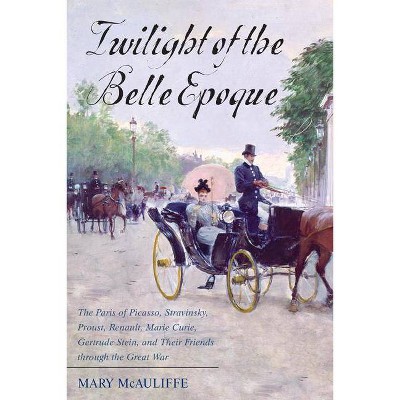
Similar Products
Products of same category from the store
AllProduct info
<p/><br></br><p><b> About the Book </b></p></br></br>In Twilight of the Belle Epoque, Mary McAuliffe portrays Paris in full flower at the turn of the twentieth century, where creative dynamos such as Picasso, Matisse, Stravinsky, Debussy, Ravel, Proust, Marie Curie, Gertrude Stein, Jean Cocteau, and Isadora Duncan set their respective circles on fire with their revolutionary visions and discoveries. But all was not well in this world, remembered in hindsight as a golden age, and wrenching struggles between Church and state as well as between haves and have-nots shadowed these years, underscored by the ever-more-ominous drumbeat of the approaching Great War--a cataclysm that would brutally bring the Belle Epoque to its close. Through rich illustrations and evocative narrative, McAuliffe brings this remarkable era from 1900 through World War I to vibrant life.<p/><br></br><p><b> Book Synopsis </b></p></br></br>Mary McAuliffe's Dawn of the Belle Epoque took the reader from the multiple disasters of 1870-1871 through the extraordinary re-emergence of Paris as the cultural center of the Western world. Now, in Twilight of the Belle Epoque, McAuliffe portrays Paris in full flower at the turn of the twentieth century, where creative dynamos such as Picasso, Matisse, Stravinsky, Debussy, Ravel, Proust, Marie Curie, Gertrude Stein, Jean Cocteau, and Isadora Duncan set their respective circles on fire with a barrage of revolutionary visions and discoveries. Such dramatic breakthroughs were not limited to the arts or sciences, as innovators and entrepreneurs such as Louis Renault, André Citroën, Paul Poiret, François Coty, and so many others--including those magnificent men and women in their flying machines--emphatically demonstrated. But all was not well in this world, remembered in hindsight as a golden age, and wrenching struggles between Church and state as well as between haves and have-nots shadowed these years, underscored by the ever-more-ominous drumbeat of the approaching Great War--a cataclysm that would test the mettle of the City of Light, even as it brutally brought the Belle Epoque to its close. Through rich illustrations and evocative narrative, McAuliffe brings this remarkable era from 1900 through World War I to vibrant life.<p/><br></br><p><b> Review Quotes </b></p></br></br><br>In Twilight of the Belle Epoque, this brilliant social historian applies her novelistic approach . . . to the early 20th century, interweaving a multitude of stories to create--through skillfully chosen glimpses into the lives of its most talented inhabitants--an unforgettable portrait of Paris. . . . Deftly, McAuliffe gathers together the threads of her multiple tales for the arrival of that ultimate rite: war. Here, to her readers' possible surprise, the artists and inventors emerge as heroes. . . . Summary reduces the various elements of McAuliffe's marvelous book to a mere cocktail of events. Harder to convey is the subtlety of the mix. With uncommon skill, she blends each ingredient of an incredible époque into a vivid and hugely enjoyable narrative of extraordinary times.--The New York Times<br><br>A sequel to her Dawn of the Belle Epoque, which took readers from the Franco-Prussian war to the 1900 Universal Exposition, McAuliffe's Twilight introduces a new cast of characters. Picasso, Stravinsky, Proust, Marie Curie, and Gertrude Stein are just a few of the creative dynamos who appear in the pages of this new volume--a lively account of an era of literary, artistic, and technical innovation that ended with the world-altering tragedy of WWI.--France Magazine<br><br>Fascinating trivia about artists in turn-of-the-century Paris adds layers of insight to a time of growth and experimentation...McAuliffe is uniquely positioned to bring this crowded cast of characters to life. She does a thorough job of cataloging the wide range of artistic and scientific achievements while managing to also offer surprising tidbits that add texture to the narrative...McAuliffe's knowledge of and enthusiasm for this time is evident on every page.--Foreword Reviews<br><br>From 1900 through the beginning of World War I, Paris was the place to be if you were an artist, author, musician, scientist, or trendsetter of any kind. Some of the most famous names that helped shape history flocked to share ideas, garner support for their cause, or simply to soak up all that creativity. In the book Twilight of the Belle Epoque, author Mary McAuliffe follows up on her first book Dawn of the Belle Epoque to take readers back to this illustrious age and shows how the looming threat of violence in Europe brought an end to one of the most creative periods in history.--Quincy Herald-Whig<br><br>However tentative its beginning and disastrous its end, the Third Republic had its glories, as Mary McAuliffe reminds us in Twilight of the Belle Epoque. The years between 1870 and 1914 were a time when Paris could fairly claim to be the cultural capital of the world. This was the France of the Impressionists and post-Impressionists, of Rodin and the young Picasso, Matisse and Braque, the France of Proust and Gide, of Debussy and Ravel. Paris became the City of Light, the center of fashion. The cinema was born; the Métro was built. The Renault brothers and André Citroën created an automobile industry. Pierre and Marie Curie, discovering the properties of radium, prepared the way for advances that transformed the modern world. In her panoramic chronicle, Ms. McAuliffe takes up all these topics, giving a year-by-year account of the second half of the era, just as she treated its first half in Dawn of the Belle Epoque (2011). Her strict chronological format creates a series of surprising juxtapositions: On one page, a young Charles de Gaulle marvels at a performance by Sarah Bernhardt; on the next, Picasso walks around Paris wielding a gun passed down by the avant-garde troublemaker Alfred Jarry. This is a work of serious history, but has some of the easy charms of the coffee-table book and is full of gossip. (When Bernhardt's anti-Dreyfus son offends her during dinner, she angrily shatters a plate.) . . . All of Ms. McAuliffe's Belle Epoque moments, bright and foreboding, build to the horrors and glories of the war of 1914-18, in which France suffered losses of almost 1.5 million men, with some three million more wounded.--The Wall Street Journal<br><br>In her prior work, Dawn of the Belle Epoque (2011), historian McAuliffe recounted how Paris, reeling from the disasters of the Franco-Prussian War and the Paris Commune, reemerged as the glittering cultural center of Europe in the last two decades of the nineteenth century. During the so-called Belle Epoque, art, literature, and science bloomed in a creative outburst, led by a cast of innovative geniuses, including Zola, Monet, Rodin, and Renoir. In her follow-up, McAuliffe covers the period from 1900 to 1914. The cast of characters as well as the political and social milieu have changed somewhat, but the cultural, scientific, and technological creativity continued to flourish. But as McAuliffe indicates, the epoch had its dark side, including the ongoing and increasingly vicious battles between monarchists and republicans, and Catholics versus secularists. The more prescient observers were haunted by the looming threat of a general European war. This is a fine tribute to an amazingly productive period in Parisian and world history.--Booklist<br><br>McAuliffe completes her chronicle of Paris-begun with Dawn of the Belle Epoque-with this volume, similar in scope and content to her initial offering. Paris serves as the essential backdrop for a year-by-year summary of the lives, loves, and achievements of the city's academic and cultural elite. The author has a keen eye for the telling, tantalizing, and occasionally titillating detail, and she has mined a host of solid secondary works as well as printed journals and memoirs to assemble this portrait. Casual readers will be astonished at the book's dramatis personae: not only Picasso, Stravinsky, Proust, Renault, the Curies, and Gertrude Stein--all name-dropped on the cover--but also Clemenceau, Rodin, Bernhardt, Duncan, Zola, Debussy, and Matisse. All told, an astonishing outpouring of artistic ability and achievement. Scholars will find a wealth of detail that brings to life the figures of tout Paris. Like its companion volume, this second 'gossipy soufflé' will charm all who love Paris, French history, and the arts. It would make a wonderful travel companion for those Paris bound, and a delightful read for all. Summing Up: Highly recommended. All 20th-century collections.--CHOICE<br><br>McAuliffe follows up her Dawn of the Belle Epoque: The Paris of Monet, Zola, Bernhardt, Eiffel, Debussy, Clemenceau, and Their Friends with this book taking readers forward a few decades. It's actually not so much a history of a time as a collection of biographies--over 30 of them--of early 20th-century French inventors, politicians, and artists. The author divides the book by year, with each chapter relating significant events in the life of the main subjects during that one year. . . . McAuliffe has an eye for the evocative, using quotes--and salacious details--to bring these early 20th-century men and women to life, several of whom--Rodin, Zola, the Curies--were covered in her previous book (she orients readers in case they did not read that volume). The author excels at including material about women throughout. VERDICT Recommended for readers who enjoyed the previous volume and for biography junkies.--Library Journal<br><br>McAuliffe revisits this vibrant, controversial era and weaves brief chronological snapshots of the eponymous figures--plus others like Sarah Bernhardt and Émile Zola--and their (often long-suffering) companions throughout her . . . eminently readable . . . narrative.--Publishers Weekly<br><br>Praise for Dawn of the Belle Epoque: A marvelous vision of Paris at its heady, uncertain best.--Publishers Weekly<br><br>Praise for Dawn of the Belle Epoque: Mary McAuliffe's book is a charming and detailed meander through the lives of the writers and artists who lived and worked in Paris. . . . Each chapter describes a year in the life of the French capital, during which the author depicts the major Parisian events and provides a fascinating variety of anecdotes, little-known facts, and background detail that any connoisseur of the city will relish. . . . The result is an informative and evocative guide to late nineteenth-century Paris that would be an ideal accompaniment to a stay in the capital. . . . A most entertaining and readable account of a fascinating era and will be useful to both students of Paris and visitors alike.--French Studies<br><br>Praise for Dawn of the Belle Epoque: McAuliffe has added a truly remarkable degree of insight into both the lives of the participants and the turbulent world they inhabited. McAuliffe paints with broad, majestic strokes a world that has been lost to us or perhaps never was.--Washington Independent Review of Books<br><br>Praise for Dawn of the Belle Epoque: McAuliffe should be strongly commended for corralling such an immense amount of data into a tightly paced, informative, and highly readable compendium. The book is sure to delight readers as much as it informs them.--Contemporary French Civilization<br><br>Praise for Dawn of the Belle Epoque: McAuliffe's deep research in both primary and secondary sources, combined with her skilled reconstruction of social and professional networks, results in a wealth of fascinating, roughly interwoven biographies and historical events. . . . [I]t is an evocative and pleasurable read.--French History<br><br>Praise for Dawn of the Belle Epoque: Reads more like a novel than an academic history. . . . Rich with the flavor of words taken from primary sources, the book provides an intimate look at the very human side of history. . . . Today's Paris rose from war and ashes, as Mary McAuliffe's Dawn of the Belle Epoque so eloquently proves.--New York Journal of Books<br><br>Praise for Dawn of the Belle Epoque: Today, Paris retains its allure as a mecca for lovers of art, fashion, and high culture. To an extent, that allure is a legacy of the Belle Epoque. . . . As the term indicates, this was an era of wonderful cultural flowering. . . . McAuliffe tracks, on a year-by-year basis, this explosion of artistic expression. She does not ignore the seamy underside of this glittering picture. . . . This is an excellent and honest portrayal of an exciting and vital era in European history.--Booklist<br><br>Praise for Dawn of the Belle Epoque: Unique and insightful. . . . In each chapter we are introduced to the key personalities and events of the era, often through excerpts from letters or diaries. I felt like I was a part of the personal lives of everyone, and by the time I finished the book I had a deeper understanding of the (real life) characters, even those I already knew a lot about. . . . The struggles and events of these years have continued to influence French politics and society right up to the present day.--The Collected Traveller<br><br>Praise for Dawn of the Belle Epoque: What a story [Mary McAuliffe] has to tell! In a world of breathtaking achievement in art, music, drama, dance, sculpture, literature, and occasionally even politics, the 'to-ings and fro-ings' of those synonymous with the period are set against the perpetual high drama that was the Third Republic. This gossipy soufflé . . . will entertain those who love the arts, French history, or Paris. . . . A fun read for all. Highly recommended.--CHOICE<br><br>You dive into this book, this period, with a swirl of the Paris Exposition of 1900, rushing to the opening of the Metro, over to the summer Olympics in Paris, the racing of cars round the street. . . . Happily read as a stand-alone but you may well thirst for the detail from Dawn of Belle Epoque. . . .The dazzling excitement of the opening chapter runs through to the intrusion and attrition of the war, completing this finely detailed, researched period. . . .[An] exceptional book.--Wordparc<br><br>Twilight of the Belle Epoque provides an immensely enjoyable whirlwind account of the many artists, innovators, and dreamers of all stripes who were drawn to the City of Lights in the first years of the twentieth century to pursue their quest for glory.--Stéphane Kirkland, author of Paris Reborn: Napoléon III, Baron Haussmann, and the Quest to Build a Modern City<br><br>With Twilight of the Belle Epoque Mary McAuliffe offers a delightful romp through one of the most vibrant periods in French history, even as she elegantly captures the shadows looming on the horizon. Those unfamiliar with this period will be awestruck by its riches, while connoisseurs will delight as McAuliffe brings to life the colorful cast of artists and innovators--from Picasso to Peugeot--who ushered in the twentieth century in the City of Light.--Rachel Mesch, Yeshiva College; author of Having It All in the Belle Epoque<br><p/><br></br><p><b> About the Author </b></p></br></br>Mary McAuliffe holds a PhD in history from the University of Maryland, has taught at several universities, and has lectured at the Smithsonian Institution. She has traveled extensively in France, and for many years she was a regular contributor to Paris Notes. Her books include Paris Discovered, Dawn of the Belle Epoque, and Clash of Crowns. She lives in New York City with her husband.
Price History
Cheapest price in the interval: 24.99 on October 22, 2021
Most expensive price in the interval: 24.99 on December 20, 2021
Price Archive shows prices from various stores, lets you see history and find the cheapest. There is no actual sale on the website. For all support, inquiry and suggestion messages communication@pricearchive.us
